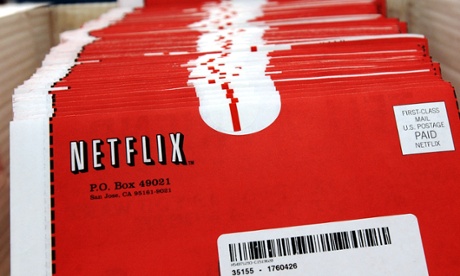
In 2014, Netflix spent $0 on marketing its DVD business. That's down from 2013, when it spent a whopping $292,000 on DVD marketing. For comparison, the firm's marketing for its streaming service cost $65m last quarter alone.
Despite the fact that Netflix is clearly trying to kill off its old business of putting shiny discs in envelopes and posting them to customers, it persists. In the company's quarterly results, released on Monday, it revealed that it had 6.26 million DVD subscribers. That's down by almost 400,000 from the quarter before, but the number is declining by less and less every year.
For many observers, that rump of subscribers is a bizarre historical anomaly, equivalent to the $196m AOL made in 2013 from members who still pay a monthly bill. And there will indeed be a number of subscribers of Netflix's DVD service – and equivalent products such as Amazon's Lovefilm by Post in the UK – simply because they are stick-in-the-muds who don't want (or know how) to start using streaming services.
But not everyone who carries on getting optical media transported to them by an exorbitantly wasteful process of rail, truck and foot is a technophobe. I know, because I do too.
When I mention that I watch the vast majority of my TV on Blu-ray discs posted to me, the news is greeted with a mixture of confusion and mockery. I've been accused of pushing the video version of audiophiles' claim that "vinyl sounds better", of failing to understand how streaming works, or simply of being a hipster who doesn't like popular things.
I do have reasons for doing it the hard way. Chief among them is that Blu-rays (which Netflix also offers through its DVD package) are significantly better quality video and audio than any streaming service currently offers. When it comes to video, it's not just a case of the headline figures, because most streaming services will offer you 1080p HD video if your connection is fast enough, but also of the bitrate that video is pushed at. Most streaming video is fairly heavily compressed to be able to make it down the wire to your home, which can show in visual artefacts on screen.
When it comes to audio, the case is even more stark. Streaming services are typically 5-10 years behind the cutting edge. For instance, Amazon's home streaming maxes out at Dolby Digital Plus, a 5.1 surround sound system which is fairly outgunned by Blu-ray's DTS-HD support.
Sure, those differences only matter to people who've already invested huge sums in their own home theatre set-ups. But for a small subset of viewers, they're important. And it's clear that Netflix knows that, because the company is slowly rolling out its "Ultra HD" videos, which are four times the resolution of a Blu-ray disc. Those videos are currently a marketing stunt, since even by the end of this year there will be just 450,000 TVs in the US even capable of playing them, but they show that Netflix is serious about quality.
Unfortunately for the streaming providers, quality isn't all in their hands. When it comes to discs, a flaky broadband connection or buggy BT Homehub can't derail the experience – something that can't be said for streaming. There's little worse than settling down for an evening movie and watching it buffer for five minutes, before playing 30 seconds then buffering again. And in a world where everything but the kitchen sink is essentially a very expensive paperweight when the internet connection fails, it's nice to know that at least the option of a film night is available.
As well as the option of a film night, of course, it's also nice to have a choice of films you actually want to watch. The paradox of Netflix's successful transformation from a DVD rental company to a streaming video firm is that as its star has risen, the selection has got worse. The company's switched its focus from film to TV, where the rights are cheaper and standards are lower (admit it, you'd never watch a film half as terrible as that reality show you binge-watch religiously). It has started making high-quality original series, in an effort to steal some of that HBO shine. And it's perennially fine-tuning its recommendations algorithms so that the more obscure films it can afford to license end up in front of the right people.
Meanwhile, the licensing requirements for physical rentals are significantly simpler, and the window for new releases is typically within a month of them hitting the shelves for sale. Which means that rather than trying to work out which episode of 1995s Star Trek Voyager to watch, I can watch last year's Star Trek: Into Darkness (a decision which, in hindsight, was not the best option).
But the thing I like most about being sent the physical media is, I'll admit, an idiosyncrasy: it's actually remarkably pleasant to be handed a movie and told "watch this, you don't get to watch anything else until you've seen it." It means that rather than slobbing out with four episodes of Friends that I've seen a hundred times, I'll make the effort to watch the worthy documentary I put on my watchlist months ago. Sometimes, in a world of instant gratification, it's nice to be held to a standard.

